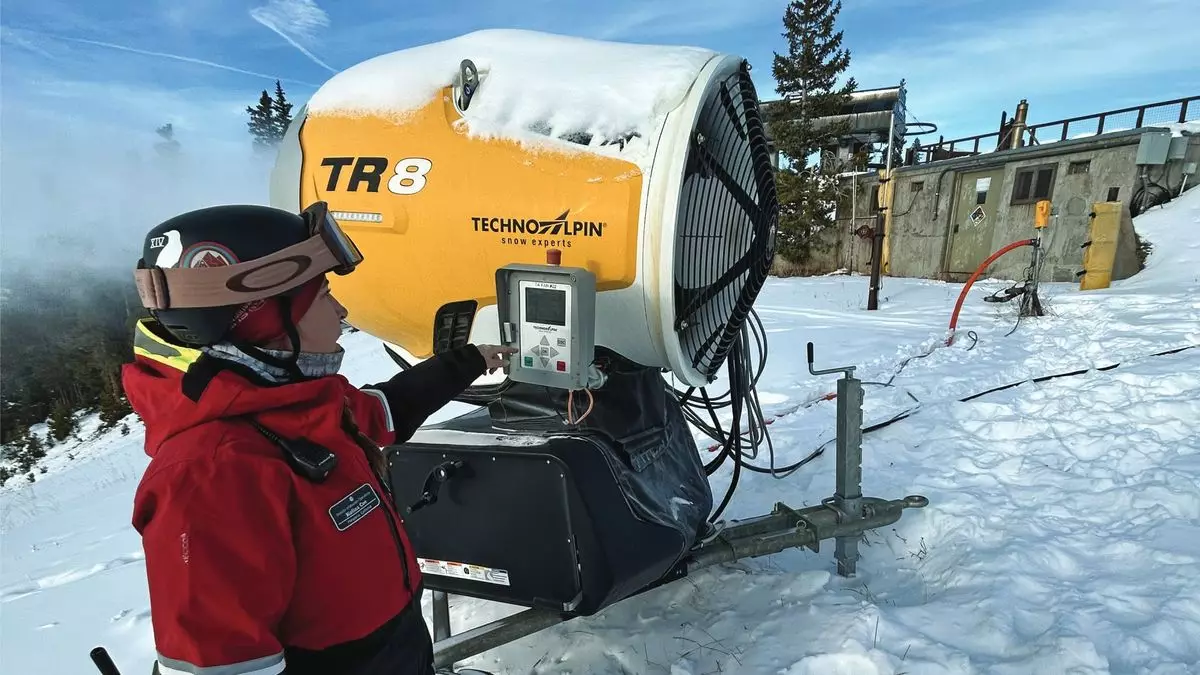As ski resorts begin preparing for the winter season, advancements in snowmaking technology are transforming how they operate. Keystone Resort in Colorado exemplifies this evolution, showcasing not only an innovative approach to snow production but also an eye toward sustainability in an increasingly unpredictable climate.
In the early hours before the Thanksgiving weekend, the majestic expanse of Dercum Mountain loomed at an elevation of 11,640 feet. While the throngs of ski enthusiasts were yet to arrive for the day’s skiing activities, the resort was already abuzz with the sound of snowmakers at work. A notable piece of equipment, a mobile fan gun from the Italian manufacturer TechnoAlpin, was stationed atop the Mozart slope. Despite the ambient temperature hovering around 32.9 degrees, the low humidity resulted in an effective snowmaking temperature of just 21.7 degrees. The diligent teams responsible for snowmaking were visibly excited as they witnessed water droplets frozen into snowflakes—a sight that marks the beginning of the ski season.
This renaissance in snow creation comes at a crucial time. With ski resorts across North America from Maine’s Sugarloaf to California’s Mammoth Mountain leveraging similar technologies, the excitement builds as visitors anticipate gliding down pristine slopes. Enhanced snowmaking capabilities not only allow for earlier openings but also reliable snow coverage throughout the season, significantly impacting resorts’ proceedings and profitability.
Keystone has made considerable investments in its snowmaking infrastructure, deploying 672 fixed and mobile snow guns across 40% of its 3,148 skiable acres. This strategic implementation allows the resort to confidently commence its ski season, even in the face of the pressing challenges posed by climate change. Notably, recent upgrades, including 53 new snow machines introduced in 2019, have improved the resort’s average opening date, which now occurs around October 27—substantially earlier than the November 8 average from the previous six years.
Aside from offering recreational joy, this operational capacity provides assurance to skiers who can confidently plan their trips knowing that snow conditions will be favorable. In the realm of competitive skiing, being one of the first resorts to open is pivotal, and Keystone has established itself among this elite group alongside nearby Loveland and Arapahoe Basin.
With the specter of climate change looming large, Keystone’s snowmaking initiatives are governed by a strong commitment to sustainability. Vail Resorts, Keystone’s parent company, stands out in this regard, having achieved 100% renewable electricity across its 37 North American resorts in recent fiscal years. Furthermore, the company is steadfast in its goal of a net-zero operation by 2030, which includes efforts to minimize waste and reduce fossil fuel consumption on-site.
As Director Kate Schifani aptly noted, the symbiosis between technological advancement and resource conservation is evident in Keystone’s policies. Automated snowmaking equipment represents a critical component of this strategy—by substantially increasing efficiency, resorts can now produce quality snow using fewer resources. Automation not only improves the speed of snow production by enabling systems to engage in a matter of minutes rather than hours but also enhances the purity and consistency of the snow produced.
During a recent visit, the sophistication of Keystone’s snowmaking operations became strikingly clear. Staff members monitored snow-making stations through a mid-mountain operations center—each equipped with smart weather metrics that dictate optimal times for snow production. This automation eliminates the guesswork and inefficiencies of manual checks, allowing operators to focus on production rather than logistics. Currently, about half of the stations at Keystone are automated, but initiatives are underway to increase this figure.
The success of automation isn’t merely conceptual; evidence from the nearby Vail Mountain underscores its impact. An initiative that introduced over 400 automated snow guns alongside the installation of 19 miles of new piping led to an efficiency surge of 85%. As Keystone looks to pursue similar upgrades, the potential environmental and operational benefits are substantial.
The progress seen at Keystone Resort represents a broader trend within the skiing industry. By prioritizing sustainable and technologically advanced snowmaking practices, Keystone not only fortifies its business against changing climate patterns but also fosters an environment conducive to growth and enjoyment for winter sports enthusiasts. As guests arrive each season, the certainty of quality snow translates to customer satisfaction and industry resilience, ultimately benefiting the entire skiing community. The future of skiing at resorts like Keystone looks bright, bolstered by ambition and innovation—an exciting narrative as the ski season unfolds.


Leave a Reply